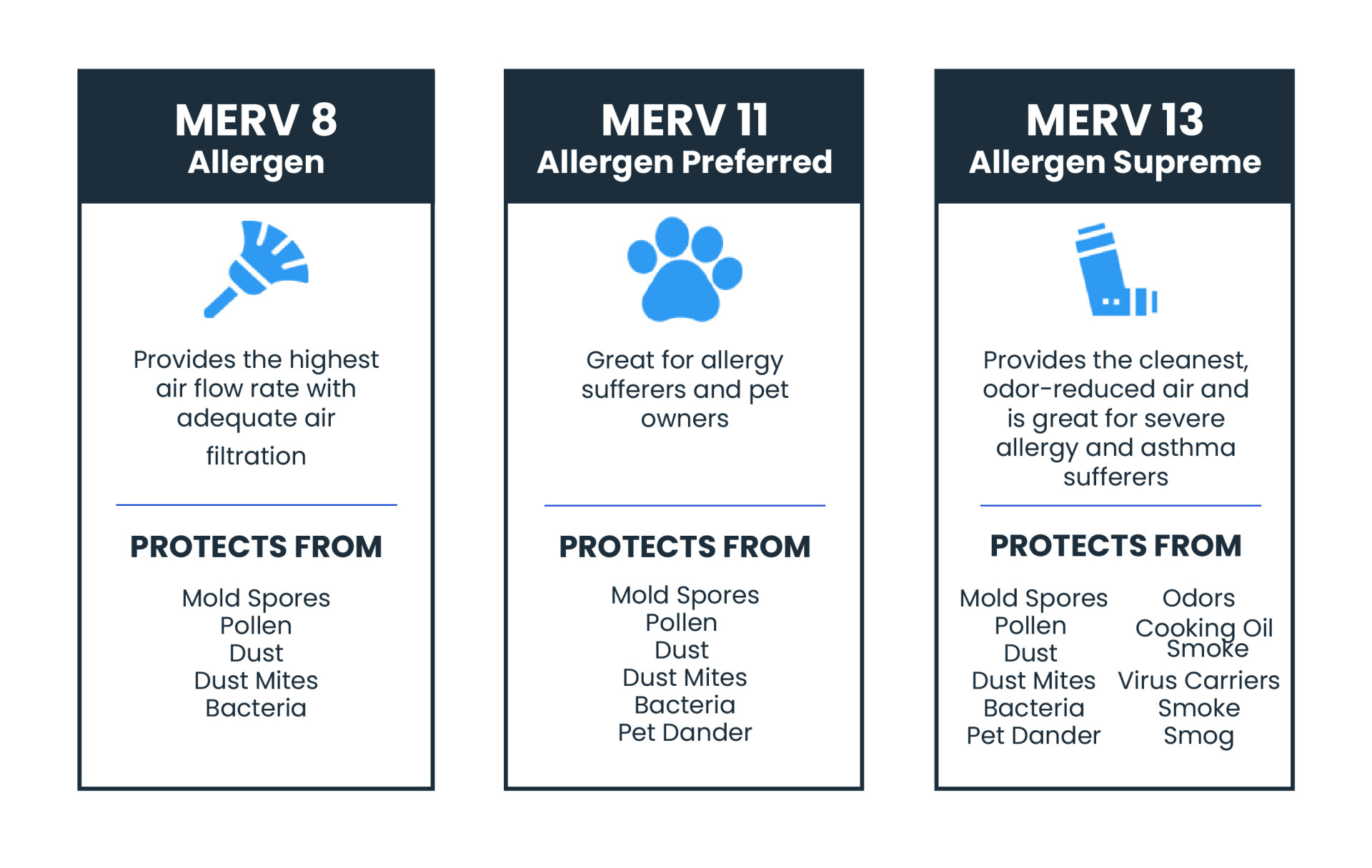- Winter-Proof Your HVAC System: What Every Homeowner Should Be Doing Right Now
- New Year, Fresh Air: 5 Simple Ways to Improve Your Home’s Air Quality in 2026
- Why Indoor Air Gets Worse in the Winter (and What You Can Do About It)
- 5 Winter HVAC Mistakes You Might Be Making (and How to Fix Them)
- Is Your HVAC Ready for Winter? 5 Things to Check Before the First Cold Snap

The air we breathe plays a crucial role in our health and well-being. Whether at home, in the office, or in public spaces, having clean and fresh air is essential. Here in the U.S., more than 34 million people live with a chronic lung disease like asthma.

Air filters are designed to improve indoor air quality by capturing airborne particles and pollutants. But take a trip to the local hardwares store, you will be face-to-face with a wall of air filter options with various filtration rating systems. In this blog post, we'll explore two of the most common: MERV vs. MPR.
What is the MERV Rating System?
MERV stands for "Minimum Efficiency Reporting Value." It is an industry-standard rating system used to assess the effectiveness of air filters in capturing and removing particles of varying sizes from the air.
Unlike MPR, which is a proprietary rating system developed by 3M, MERV is a universally accepted method established by the American Society of Heating, Refrigerating, and Air Conditioning Engineers (ASHRAE). This standardization allows consumers to make informed decisions when selecting air filters. We use the MERV rating system here at FilterTime.
How MERV Works
The MERV rating system evaluates an air filter's performance based on its ability to trap and remove particles of different sizes from the air. The process involves subjecting the filter to a series of controlled tests to determine its efficiency in particle capture, from large dust particles to tiny airborne contaminants. The size range includes particles as small as 0.3 microns up to 10 microns and above.
During testing, the air filter is exposed to a controlled airflow containing particles of various sizes. The filter's efficiency in capturing these particles is then measured, and the results are compared to the established MERV rating scale. It ranges from 1 to 20, with higher numbers indicating greater particle capture efficiency. Filters with higher MERV ratings can remove a higher percentage of particles across a wider range of sizes.
Based on the numbers you think you’ll probably need the highest filtration, this is actually false. If the filtration is too high it could negatively affect your HVAC system; typically the highest it should be in a home is a 13. At FilterTime, we offer MERV 8, MERV 11 and MERV 13.

Still have questions about MERV? Watch our co-founder Blake Koch explain the differences in this short video.
What is the MPR Rating System?
MPR, which stands for "Micro-Particle Performance Rating," is an air filter rating system developed by 3M. They are a renowned multinational conglomerate known for its innovation in various industries, including filtration technology.
The primary purpose of the MPR rating system is to measure the efficiency of air filters in capturing tiny particles that can be harmful to human health. These particles are often invisible to the naked eye. This is why they are a significant concern for indoor air quality.
The MPR rating scale typically ranges from 300 to 2800. Each number represents the filter's ability to capture particles of varying sizes. The higher the MPR rating, the more effective the air filter is at capturing smaller particles.
The MPR rating system is particularly tailored to address allergens and pollutants commonly found in residential settings, such as pollen, pet dander, mold spores and some bacteria.
How MPR Works
The MPR rating system evaluates an air filter's efficiency by measuring its performance in capturing particles as small as 0.3 microns. To put this into perspective, a human hair is typically about 50 to 100 microns in diameter. Basically, we are talking about particles that are around 100 times smaller than a single strand of hair.
These microscopic particles are known to be common indoor allergens and can cause discomfort and health issues, particularly for individuals with allergies, asthma or other respiratory conditions.
MPR-rated filters are designed to trap these particles. They prevent them from circulating in the air and potentially causing respiratory problems or allergic reactions.
What's the Difference between MERV and MPR?
Let's compare MERV and MPR by looking at some of the above details and others. This will give you a good idea of the differences between them.
- Particle Size Efficiency: MERV, assesses a filter's ability to capture particles of different sizes. These range from large dust particles to smaller allergens and even some viruses. MPR, on the other hand, is tailored to measure the efficiency of filters in capturing microscopic particles as small as 0.3 microns.
- Rating Scale: MERV uses a wider scale (1 to 20) compared to MPR's narrower rating scale (300 to 2800).

- Testing Methods: MERV, being an industry standard, follows specific testing procedures and guidelines set by ASHRAE. This transparency allows consumers to have a clearer understanding of how a filter's efficiency is measured. MPR's testing methodology is not publicly disclosed, as it is a proprietary rating system owned by 3M.
Are you looking for quality air filters? At FilterTime, you will get air filters delivered straight to your door automatically, hassle-free, with our convenient subscription service. Or, if you prefer, make a one-time purchase to experience the difference for yourself. Click here to get started.
« Back to News





